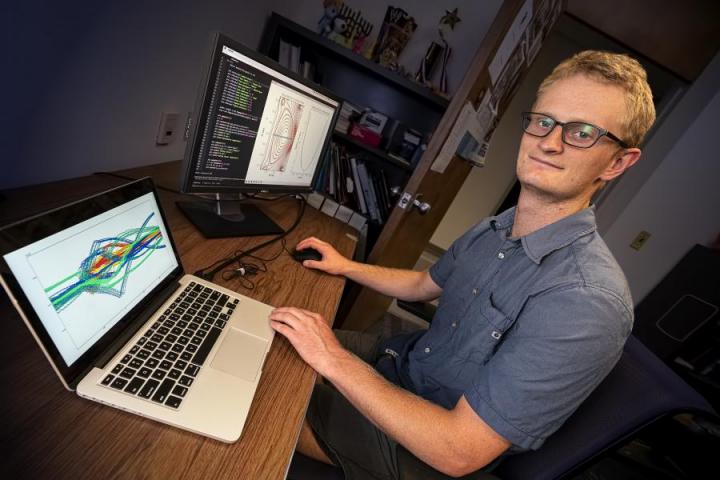
Credit: Elle Starkman/PPPL Office of Communications.
Researchers have found that injecting pellets of hydrogen ice rather than puffing hydrogen gas improves fusion performance at the DIII-D National Fusion Facility, which General Atomics operates for the U.S. Department of Energy (DOE). The studies by physicists based at DOE’s Princeton Plasma Physics Laboratory (PPPL) and Oak Ridge National Laboratory (ORNL) compared the two methods, looking ahead to the fueling that will be used in ITER, the international fusion experiment under construction in France.
Improve the temperature
The researchers showed that icy pellets of hydrogen improve the temperature of the fusion plasma when compared with the gas fueling method now typically used in doughnut-shaped fusion facilities called tokamaks. Higher temperatures are beneficial for the fusion reactions. The results on DIII-D are encouraging for ITER, which plans to use pellet injection to fuel its hot inner core.
Fusion, the power that drives the sun and stars, combines light elements in the form of plasma – the state of matter that consists of positively charged atomic nuclei and negatively charged electrons – to create massive amounts of energy. Scientists seek to replicate fusion on Earth for a safe, clean and virtually inexhaustible supply of power to generate electricity.
One challenge for producing fusion energy is how to get cold hydrogen fuel into the hot plasma core. The sun has all the hydrogen that it needs for billions of years, but fusion reactors on Earth must constantly feed hydrogen into the plasma to sustain the fusion reactions. Puffing room-temperature gas is the most common way to inject hydrogen in current experiments.
Bigger and hotter
However, as fusion reactors get bigger and hotter it will become harder for the gas to penetrate into the core of the reactor where fusion reactions take place. New methods thus need to be developed to feed the fusion core without degrading the plasma performance.
The joint research effort on DIII-D compared the two fueling methods in high-performance plasmas planned for ITER. The experiments revealed a significantly higher pressure of plasma — a key to fusion reactions — using hydrogen ice compared to gas injection when the rate of fueling is roughly evenly matched between the two methods.
“The fueling plays a big role in the edge plasma performance,” said Andrew “Oak” Nelson, a graduate student in the Program in Plasma Physics at Princeton University and first author of the Nuclear Fusion article describing these results. Nelson is part of a multi-institutional team that carefully designed and executed the experiments.
Scientists at ORNL
The technology for injecting the ice pellets was developed by scientists at ORNL. Interpretation of the experimental results requires sophisticated scientific instruments developed by multiple collaborating institutions on DIII-D. “It’s great to see how our multi-institutional effort came together to tackle this important fueling question for ITER and future reactors,” said Morgan Shafer, a lead research scientist at ORNL and a coauthor of the paper.
The research also demonstrates how graduate students can make important contributions to fusion energy by working on these large national research facilities. “For a graduate student to play an important role in this experimental study on DIII-D is impressive,” said Egemen Kolemen, a PPPL and Princeton University physicist who was an advisor for the project. “Oak’s success shows how large fusion experiments provide significant leadership opportunities for students and early career scientists.”
###
The DOE Office of Science supported this research.
PPPL, on Princeton University’s Forrestal Campus in Plainsboro, N.J., is devoted to creating new knowledge about the physics of plasmas — ultra-hot, charged gases — and to developing practical solutions for the creation of fusion energy. The Laboratory is managed by the University for the U.S. Department of Energy’s Office of Science, which is the single largest supporter of basic research in the physical sciences in the United States and is working to address some of the most pressing challenges of our time. For more information, visit energy.gov/science.
About the DIII-D National Fusion Facility. DIII-D, the largest magnetic fusion research facility in the U.S., is operated as a national user facility by General Atomics for DOE’s Office of Science. It has been the site of numerous pioneering contributions to the development of fusion energy science. DIII-D continues the drive toward practical fusion energy with critical research conducted in collaboration with more than 600 scientists representing over 100 institutions worldwide. For more information, visit http://www.
Media Contact
John Greenwald
[email protected]
609-243-2672
Original Source
https:/
Related Journal Article
http://dx.




